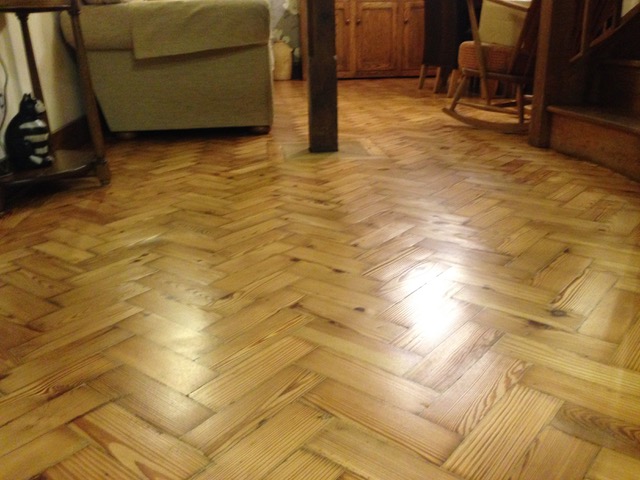Expert Advice - Restoring Parquet Flooring
Share
Copy Link
Parquet flooring is so popular right now and with so many beautiful styles and finishes, it's easy to see why. If you are fortunate enough to purchase a new home and rip back the carpets only to find the original parquet, then you will most likely be able to restore it and keep the original flooring.
We chat to The Floor Restoration Company who share their advice on original parquet floor restoration - as well as some stunning photos too!
If you are thinking about a renovation in the near future and need some help with where to start with your project, try our renovation advice session.
Renovation Advice Session
What is the process behind original parquet floor restoration?
Processes depend on age and condition; age is especially important when considering your parquet floor restoration as the parquet will no doubt have been covered in the past with carpets and rubber underlays etc. When these coverings are lifted the blocks are often found to be loose and in some cases rotten and requiring replacement.
The best condition parquet floors are those that have been left uncovered because the wood has been allowed to ‘breathe’.
Parquet floors became very popular from the 1940s onwards and were laid upon inferior substrates that lacked the reliability of our modern day concrete and underfloor damp proof membranes. This has led to the deterioration of a lot of parquet floors for the reasons mentioned above - do not fear though as only in exceptional cases is the parquet irredeemable.

Wonderful inlaid marquetry contrasts with this wonderful oak parquet floor. Image source The Floor Restoration Company.
What are the common issues with parquet flooring that need to be corrected?
Common issues with parquet floors and especially old parquet are:
- Loose and un-bonded blocks
- Rotten and unsound blocks
- Missing blocks and areas filled with concrete instead of replacing the blocks
- Gaps between the blocks
- Poor surface finishes and appearance
- Block sections that lift from the floor due to failed substrates
- Inappropriate blocks of a different species fitted into the floor
- Lack of expansion joints causing buckling of the parquet
Are there any instances that parquet flooring can't be salvaged?
Very rarely - except for the case below - as per the photo! It's the worst condition parquet floor we have ever seen - this 1940s floor was completely destroyed by dampness and had turned to sawdust having suffocated under the carpet underlay for so many years!

Parquet flooring beyond restoration. Image source The Floor Restoration Company.
Can I restore parquet flooring myself or do I need a professional?
Whilst there are certain tasks that a DIY person could take there are are a number of tasks and not least the sanding and finishing of the floor that should only be undertaken by professionals that possess the correct oscillating sanding equipment; so many parquet floors have been spoilt by the owners hiring drum sanders from their local hire shops that have resulted in a scratched and damaged parquet floor.
Specialist machinery is also required for some of the repairs and alterations required for a parquet floor restoration. Even if this is hired, the standard of the finished results can only be obtained by a trained and skilled user of the machines.
How much does it cost on average for a parquet floor restoration per metre squared?
This will depend on the extent of the repairs required - if the parquet just needs to be sanded and refinished then allow around £45 per metre squared.

Oak parquet before. Image source The Floor Restoration Company.

Oak Parquet after. Image source The Floor Restoration Company.
Are there any finishes of parquet flooring that are popular right now?
Almost everyone chooses to retain the natural colour of the parquet. Application of matt lacquer products helps to provide the floor with a natural looking finish, as if the floor had been traditionally waxed.
Once the parquet floor has been restored, how do I look after it and how long does it last until I need to restore it again?
The parquet will last a very long time before anything needs to be done again. As with all other wood floors, as the lacquer wears the lacquer will require re-application from time to time (usually every 7 years or so) and apart from this the parquet last indefinitely; and certainly longer than some of the cheaper engineered floors that only have 2mm of real wood compared to solid parquet with up to 22mm of solid wood!
Is there anything else I should consider with parquet floor restoration?
Parquet floors are becoming increasingly popular and as a company specialising in the refurbishment of the floors we have seen a dramatic increase in the number of enquiries from people wanting to restore these floors. The English have a real passion for real wood floors and that's good news for all of us!
If you are thinking about a renovation in the near future and need some help with where to start with your project, try our renovation advice session.
Renovation Advice Session
Here are some of the different types of parquet flooring....

Parquet pine flooring. Image source The Floor Restoration Company.

Parquet pitch pine flooring. Image source The Floor Restoration Company.

Parquet oak flooring. Image source The Floor Restoration Company.

Parquet teak flooring. Image source The Floor Restoration Company.



